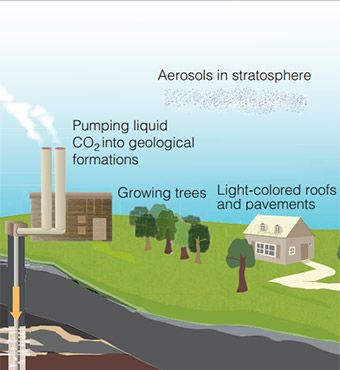Can Engineering Change Our Climate for the Better? Part 2
Can Engineering Change Our Climate for the Better? Part 2


Part One of "Can Engineering Change Our Climate for the Better?" introduced you to new areas of climate engineering. Here are some additional methods.
Solar Radiation Management
These methods are being considered to reduce the amount of solar radiation impacting the planet. Developments in this field are limited to computer modeling or laboratory tests. Testing in the field has been met with strong resistance because of unknown impacts. Key solar radiation management strategies include:
- Particle Injection. This approach involves injecting sulfate particles into the stratosphere to reflect sunlight and reduce global temperatures. “There is a wide range of climate engineering methods for deploying sulfates, including aircraft schemes, aviation fuel additives, rockets, artillery, balloons, and tethered hoses,” says Gordon. “Other chemical compounds, such as calcium carbonate and silver nitrate, are also being investigated.”
- Cloud Brightening. A similar approach to particle injection, cloud brightening involves dispersing tiny particles of water into the atmosphere to increase the reflection of sunlight (for example, seeding marine clouds with seawater droplets to increase the reflection of sunlight). Methods include using drones to discharge a fine spray of water particles into cloud systems. Engineers have designed special nozzles that can emit particles that are small enough (about 0.25 micrometers) to rise and remain suspended in air.
- Increased Reflection. Increased reflection can be accomplished through many different scientific and engineering approaches, says Gordon, including” painting rooftops, roads, and other surfaces white, employing crop varieties that increase albedo, covering deserts and glaciers with reflective plastic sheeting, putting floating panels over lakes, and creating microbubbles under the ocean.”
If climate disruption accelerates, so could the demand for climate engineering solutions.Prof. Deborah Gordon, Carnegie Mellon University
Moving Forward
The greatest concern with climate engineering is that it may disrupt natural systems at a very large scale, causing serious damage to the environment and human populations. For example, research at the University of Exeter, UK, suggests that targeting geoengineering in one hemisphere could have a severely detrimental impact for the other. Models show that injections of aerosols in the northern hemisphere would reduce tropical cyclone activity, yet at the same time increase chances for drought in sub-Saharan Africa
“The field of climate engineering is in its relative infancy,” Gordon says. “New climate engineering techniques are likely to materialize as the more we learn. If climate disruption accelerates, so could the demand for climate engineering solutions.”
Mark Crawford is an independent writer.





